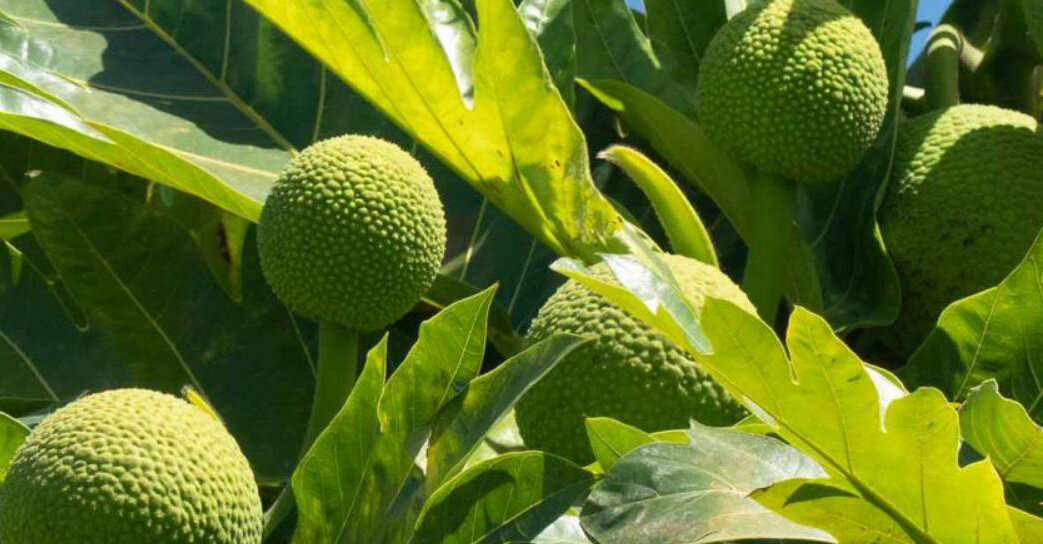Lā ‘Ulu – Breadfruit Day
Concerns about COVID have postponed this year’s celebration of Lā ‘Ulu, or Breadfruit Day. However, it’s still a good time to focus on this extraordinary plant.
So why does ‘ulu (the Hawaiian word for breadfruit) deserve its own day? What’s all the fuss about?
First, breadfruit is a nutritional powerhouse.
“Breadfruit is high in complex carbohydrates, low in fat, and cholesterol and gluten free. It has a moderate glycemic index (blood sugar shock) compared to white potato, white rice, white bread, and taro. Just 100 g of breadfruit (approximately ½ cup) provides 25% of the RDA for fiber, and 5–10% of the RDA for protein, magnesium, potassium, phosphorus, thiamine (B1), and niacin (B3). Breadfruit also provides some carotenoids, such as β-carotene and lutein, which are not present in white rice or white potato.” (Hawaii Department of Agriculture)
Second, it’s a renaissance plant.
We’ll mention some of the ways breadfruit can be prepared in a moment, but don’t overlook the importance of the breadfruit tree. Rachel Landis notes that “all parts of the tree, including the unripe fruit, are rich in latex, which can be used as a waterproof sealant, a paint when mixed with pigments, or in chewing gum. The leaves of the tree are often used as feed for livestock, fiber from the bark is traditionally fashioned into fabric for clothing, and the flowers can be burnt as a natural, powerful, insect repellant. The wood of the breadfruit tree is especially useful, thanks to its light weight and durability. The wood is used for everything from surfboards, traditional Hawaiian drums, and canoes, to building materials for houses, especially roofs.”
Third, some experts believe that ‘ulu could play a critical role in increasing Hawaii’s food security and fighting climate change.
According to the National Tropical Botanical Garden, breadfruit “may be the key to preventing the loss of traditional and culturally significant food crops and stabilizing food and economic security in the tropics.”
Food writer David Neimanis notes that “promoted as the next superfood, breadfruit just might be the world’s most ecological carbohydrate, and on the verge of a much-needed renaissance in Hawaii and beyond. Breadfruit grows on a long-lived tree, which gives it high water and nutrient efficiency, and the tree’s roots help it absorb carbon from the atmosphere and store it underground. It’s also a key element in multistory agroforestry, an increasingly popular approach to growing food in the face of the climate crisis.”
So how do you eat breadfruit?
Preparation can be as simple or sophisticated as you prefer. According to Rachel Landis, “breadfruit can be eaten at any stage of ripeness, in both sweet and savory forms. When unripe, the fruits are closer to a potato, and are generally prepared as such. Once the fruit ripens, however, the inside becomes almost like a custard in both taste and texture, and is often eaten simply as is.”
If you like to cook, there’s no limit to the things you can whip up with breadfruit. Vegan recipes using ‘ulu are easy to find online. For example, the Hawaii ‘Ulu Cooperative offers 29 vegan recipes that include pudding, Cajun fries, pizza, chowder, desserts, noodles, soups and more.
Photo from https://mnbg.org/la-ulu-breadfruit-day/
More information
Promotes the conservation, study and use of breadfruit for food and reforestation. Offers many resources related to growing, cooking and environmental impact.
Offered by the Hawaii ‘Ulu Cooperative
Breadfruit Nutrition Fact Sheet
Prepared by the Hawaii Department of Agriculture
Hawaiian 'Ulu (Breadfruit): Neither Bread, Nor Fruit
Rachel Landis offers a concise history and overview.
Reviving Breadfruit, the Polynesian Staple, Could Nourish People and Fight Climate Change
Food writer David Neimanis weighs in on the environmental potential.


